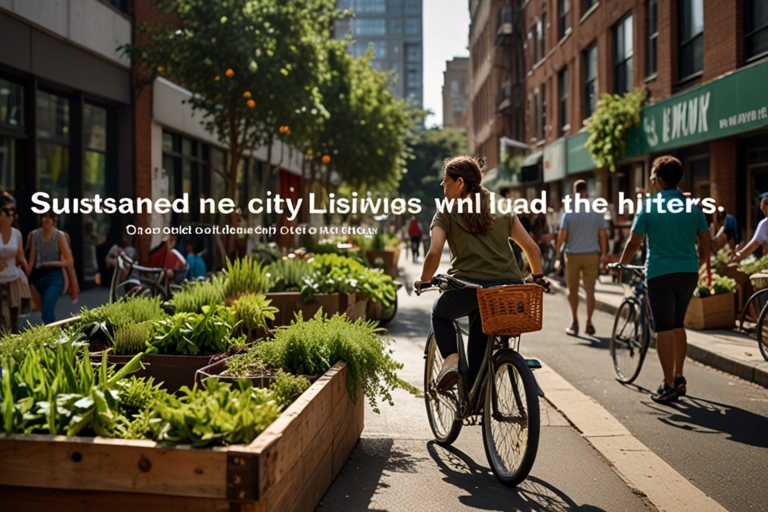Living in a city can make sustainable living seem challenging, but with the right approach, urban dwellers can make eco-friendly choices that benefit the environment. Sustainable living involves adopting practices that reduce our impact on the planet while still enjoying a modern lifestyle. This article will provide practical tips to help city residents lead a more sustainable life, even in an urban setting.
1. What is Sustainable Living?
Sustainable living means making choices that use fewer resources and produce less waste. The goal is to minimize our carbon footprint and help protect the environment for future generations. While living in a city might limit some eco-friendly options, there are still plenty of ways to live sustainably.
2. Benefits of Sustainable Living in Cities
Urban areas often struggle with pollution, high energy consumption, and waste. Sustainable living can help address these issues in several ways:
- Reduces pollution: Sustainable habits like using public transportation and reducing plastic waste can cut down on air and land pollution.
- Saves money: Many eco-friendly practices, such as energy conservation and minimalism, also help reduce expenses.
- Improves quality of life: Green spaces, clean air, and sustainable food choices contribute to a healthier lifestyle.
3. Practical Sustainable Living Practices for Urban Dwellers
Here are some simple and effective ways for city residents to embrace sustainable living:
a. Use Public Transportation or Carpool
City living usually provides access to public transportation, such as buses, subways, and trains. Using these options instead of driving a car can significantly reduce your carbon footprint.
- Ride a bike or walk: For shorter distances, walking or cycling is not only eco-friendly but also good for your health.
- Carpool or ride-share: When you need to use a car, sharing rides with others helps reduce the number of vehicles on the road.
b. Reduce Energy Use at Home
Urban apartments often consume a lot of energy, but there are ways to cut down on energy use.
- Turn off lights and unplug electronics when not in use. Even standby power can consume energy.
- Use energy-efficient appliances and light bulbs, such as LED lights, which use less electricity.
- Take shorter showers to conserve water and reduce the energy needed to heat it.
c. Minimize Waste by Recycling and Composting
Urban areas generate a lot of waste, but much of it can be reduced through recycling and composting.
- Recycle properly: Sort materials like paper, plastic, glass, and metals according to local recycling guidelines.
- Compost organic waste: Even if you live in an apartment, there are indoor composting options available. Composting reduces the amount of food waste that ends up in landfills.
d. Support Local and Sustainable Businesses
Urban dwellers have access to various local businesses that offer sustainable products and services.
- Buy from local farmers’ markets: Purchasing locally grown produce reduces the carbon footprint associated with transporting food from far away.
- Choose eco-friendly products: Look for items made from sustainable materials, such as bamboo toothbrushes, reusable bags, and eco-friendly cleaning products.
e. Create a Green Space at Home
Even in a small apartment, you can bring nature indoors by creating a small green space.
- Grow indoor plants: Plants improve air quality and add a touch of nature to your living space. Easy-to-maintain plants like succulents and ferns are great for beginners.
- Start a balcony or rooftop garden: If you have outdoor space, consider growing herbs, vegetables, or flowers in pots. This helps reduce the need to buy packaged produce.
4. Challenges of Sustainable Living in Cities
While there are many benefits, urban dwellers may face some challenges when trying to live sustainably:
- Limited space: Many city apartments have limited space for composting or growing plants.
- Higher costs: Some eco-friendly products may have a higher upfront cost, although they save money over time.
- Lack of facilities: Not all cities have adequate recycling programs or access to renewable energy.
5. Staying Committed to Sustainable Living
Consistency is key to making sustainable living work in a city. Here are some tips to help you stay committed:
- Set realistic goals: Start with one area of sustainable living, like recycling or reducing energy use, and gradually add more practices.
- Join local eco-friendly groups: Connect with others who share your interest in sustainability. This can provide support and motivation.
- Track your progress: Monitor how much waste you reduce or how much energy you save to see the positive impact of your efforts.
6. Conclusion
Sustainable living is possible for urban dwellers with a bit of planning and effort. By making small changes like using public transportation, conserving energy, and supporting local businesses, city residents can contribute to a healthier planet. While challenges exist, the benefits of sustainable living far outweigh the obstacles, leading to a better quality of life and a reduced environmental impact.
With these tips, you can start making your city life more eco-friendly in 2024. Remember, every small action adds up, and together, we can make a big difference in protecting the Earth.
See More


